The best soda maker
SodaStream wins again.

By Anna Perling, Dorie Chevlen and Jamie Wiebe
This post was done in partnership with Wirecutter. When readers choose to buy Wirecutter's independently chosen editorial picks, Wirecutter and Engadget may earn affiliate commission. Read the full guide to soda makers.
To elevate water from a flat biological necessity to a fun, bubbly treat, your best option—environmentally and financially—is a home soda maker. Since 2015, we've spent over 200 hours researching and testing 14 models (plus our own DIY version), and after drinking gallons of seltzer, we think the easy-to-use SodaStream Fizzi OneTouch makes some of the fizziest, tastiest sparkling water.
For years, SodaStream has dominated the world of home soda makers. After looking for any other worthy competitors, we've found that the company still makes machines that work better than any other store-bought option we've encountered. We think the Fizzi OneTouch is the best of SodaStream's available offerings due to its easy-to-control fizzing mechanism and sleek design.
If the SodaStream Fizzi OneTouch is unavailable, the Fizzi makes a good alternative. It made equally bubbly water in our tests, and its bottles are just as easy to insert. However, unlike the OneTouch, the Fizzi isn't automated and provides no indication of fizz level. As a result, it can be hard to tell how much you've fizzed, which makes it possible to accidentally over-carbonate and cause the bottle to overflow.
The iDrink Drinkmate is a great option if you want to experiment with carbonating other drinks in addition to water. In our tests, it successfully carbonated rosé and mocktails. Carbonating anything besides water in SodaStream machines, in contrast, will void your warranty.
Why you should trust us
In reporting this guide, we sought the advice of some of the best soda experts we could find: Jeffrey Morgenthaler, the bar manager at Portland, Oregon's Clyde Common and Pépé Le Moko; water sommelier Martin Riese; and craft soda-syrup makers Chris Onstad and Dan McLaughlin of Portland Soda Works. We previously talked with Emma Christensen, managing editor at Simply Recipes and author of True Brews: How to Craft Fermented Cider, Beer, Wine, Sake, Soda, Mead, Kefir, and Kombucha at Home; Jackson Anderson, founder of Blue Blaze Soda & Syrup Company; and Jeremy Butler, food scientist, blogger at The Homemade Soda Expert, and author of Making Soda at Home: Mastering the Craft of Carbonation. For the science behind carbonated water, we talked to Gavin Sacks, PhD, associate professor at Cornell University's Department of Food Science.
Updates writer Dorie Chevlen's prior experience with fizzy drinks was mostly limited to a healthy appreciation for gin and tonics, but after consuming liters' worth in researching and testing soda makers for the 2019 update, she's an enthusiastic seltzer convert. Staff writer Anna Perling, who wrote the 2017 update, is a longtime seltzer lover who, before she got a soda maker herself, was known for going through 12-packs of seltzer cans in just a few days. This guide also builds on the work of Jamie Wiebe, whose research included building a DIY soda maker.
For this update, we looked at the soda maker offerings at home-goods retailers such as Bed Bath & Beyond, Target, and Williams-Sonoma, as well as Amazon's top-rated models. We also combed the internet for any new soda-maker reviews and roundups.
Who should get this
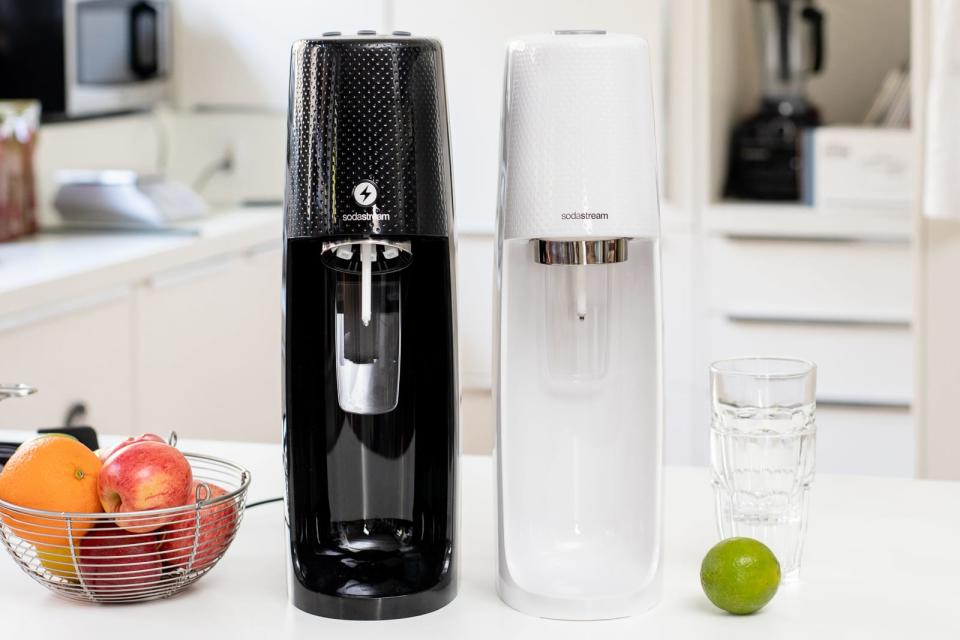
If you love sparkling water and are tired of lugging home bottles or cans, investing in a soda maker allows you to carbonate regular tap water easily (although we recommend filtering your water first). Since the models we recommend come with reusable plastic bottles and use refillable cylinders of carbon dioxide, they generate less waste than you would buying cans or bottles. If one refill cylinder can carbonate about 60 liters of seltzer, that means you won't be purchasing about 60 plastic bottles.
Using refillable CO2 cylinders is more cost-effective than paying for store-bought seltzer, too. Generic seltzer costs about 80¢ per liter, while LaCroix costs about $1.50 per liter. In contrast, SodaStream promises that each proprietary $15 60-liter refill will fizz about 60 liters of water, so it costs about 25¢ per liter to carbonate with a SodaStream (plus another 5¢ per liter to add flavor). To save yet more money, you can find DIY alternatives to purchasing refill cylinders, such as this one from mixologist Jeffrey Morgenthaler. But these DIY rigs still take an initial investment, and they may be too bulky for some kitchens.
How we picked
Soda makers work by injecting carbon dioxide into water to produce effervescence, making seltzer (not to be confused with club soda, soda water, or mineral water, which contain salts and minerals, or with tonic water, which contains sweeteners and quinine). At its simplest, a good soda maker should easily add enough carbon dioxide to produce water with a zippy, Perrier-like fizz. But beyond that, there are a few criteria we looked for when deciding what to test:
Allows you to adjust the fizz
We preferred soda makers that make it easy to choose and adjust the level of carbonation in your water. While some people may prefer seltzer with a light fizz, others like a more robust, nose-tickling beverage, and it's nice to have a machine that can do both. It's also great to be able to pump up the fizz if you're planning to use the seltzer for mixed drinks. As water sommelier Martin Riese explained, "When you want your cocktail to have bubbles in it, you need a base product that has tons of bubbles in it. If the bubbles are already small and then you dilute it with a cocktail, you can barely taste the carbonation anymore."
Uses CO2 cylinders
Most soda makers use a cylinder to inject the CO2, which is the most effective method. But over the years we've seen a few that use alternative carbonating methods such as sodium bicarbonate tablets or pods filled with carbonator beads. Siphons and handheld soda makers use one-time CO2 cartridges that are good for carbonating only about one liter of water. These alternative carbonating methods don't allow you to adjust the level of carbonation, and we've found that they don't make especially fizzy water (this Serious Eats article explains why). They also create more waste, so after initially trying a couple, we've decided to skip anything that doesn't use a CO2 cylinder.
CO2 cylinders are easy to find
The main issue many people have with SodaStream machines and similar soda makers lies in the continual need to exchange the CO2 cylinders when they run out of gas (though you can find some options out there for hacking SodaStream's proprietary carbonating method in order to use much larger cylinders). We looked for soda makers that were compatible with SodaStream cylinders, the most readily available refills. SodaStream cylinders are easily exchangeable at retailers like Bed Bath & Beyond, Target, and a range of grocery and specialty kitchen stores. SodaStream has a participating-store locator for finding one near you, and you can exchange cylinders by courier in a few larger cities. Exchanging a 60-liter cylinder runs about $15 at the time of this writing.
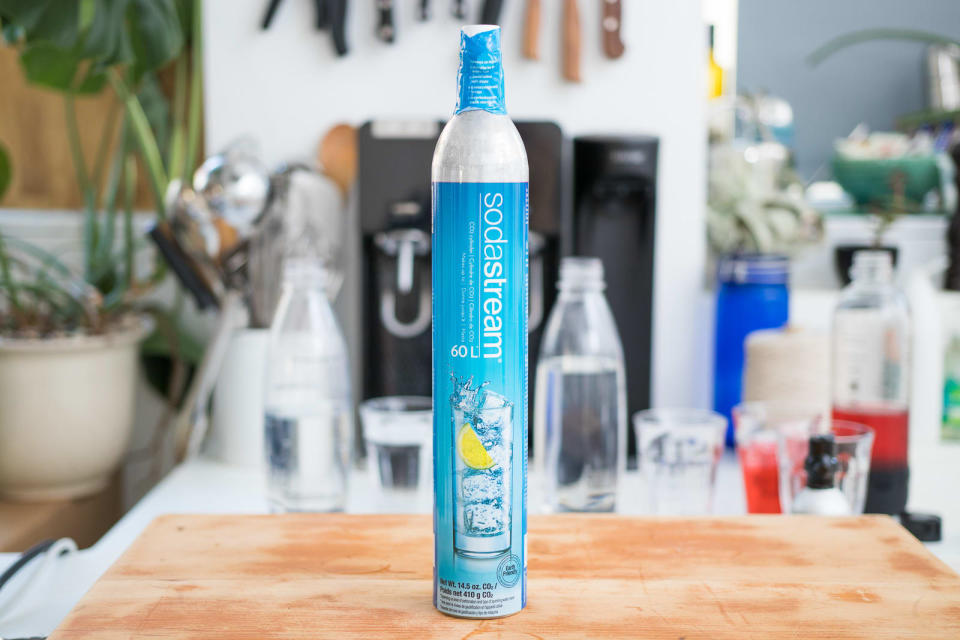
Over the years we've found fewer and fewer competitors against SodaStream that meet our criteria. It remains the brand to beat and has generally performed well in our tests, producing satisfyingly fizzy water. But there are downsides to SodaStream's domination. We were disappointed to learn that our long-time top pick, the SodaStream Source, was discontinued and not replaced by a similar mid-priced model. Instead, SodaStream now offers the Fizzi, a more basic model that lacks the Source's clear indicators of fizz level, for almost the same price as the Source. The next step up from that, the automated Fizzi OneTouch, is easier to use than the Fizzi but more expensive than the Source was, and it needs to be plugged in. SodaStream's newer models also come with only a two-year warranty, which is typical of many small kitchen appliances but a downgrade from the limited lifetime warranty SodaStream offered with older models.
For our 2019 update, we tested the SodaStream OneTouch and Fizzi against our previous top pick (the Source) and upgrade pick (the Power); both have since been discontinued.
How we tested
We began our testing by setting up each soda maker, noting how easy it was to assemble and how much counter space it occupied. We then carbonated water that we had filtered and chilled overnight in the fridge, because to make the fizziest results, the water should be cold. We took into account how easily each soda maker allowed us to control the fizz levels and then visually compared the overall fizz level and bubble size in the sparkling water from each soda maker. Finally, we conducted a blind taste test with a panel of seltzer lovers. We gave each tester soda water from each machine in a smooth-walled drinking glass (to avoid any extra nucleation sites, which increase carbonation, caused by ridges or bumps) to compare mouthfeel and flavor, looking for seltzer with good bite and no off tastes.
In our 2019 test, we also judged the fizz level by adding a Mentos to a glass of soda water from each model, which accelerated the nucleation process and released the carbonation quickly. We wanted to see if any seltzer maintained its fizz longer (an indication of more bubbles), but they all fizzled out about equally. Ultimately, our picks hinged more on the mouthfeel of the bubbles and how easy it was to adjust their level to our taste.
Although SodaStream machines can carbonate only water, the iDrink Drinkmate can carbonate anything. To explore the Drinkmate's capabilities in our 2017 testing, we gave our panel a sampling of pre-carbonated, bottled sparkling apple juice to compare in a blind taste test against apple juice from the same brand carbonated with the Drinkmate. To see how the Drinkmate worked with different beverages, we also tried carbonating rosé and chilled water mixed with Portland Soda Works's Rose Cordial Syrup (to mimic a premixed cocktail or mocktail).
Our pick: SodaStream Fizzi OneTouch
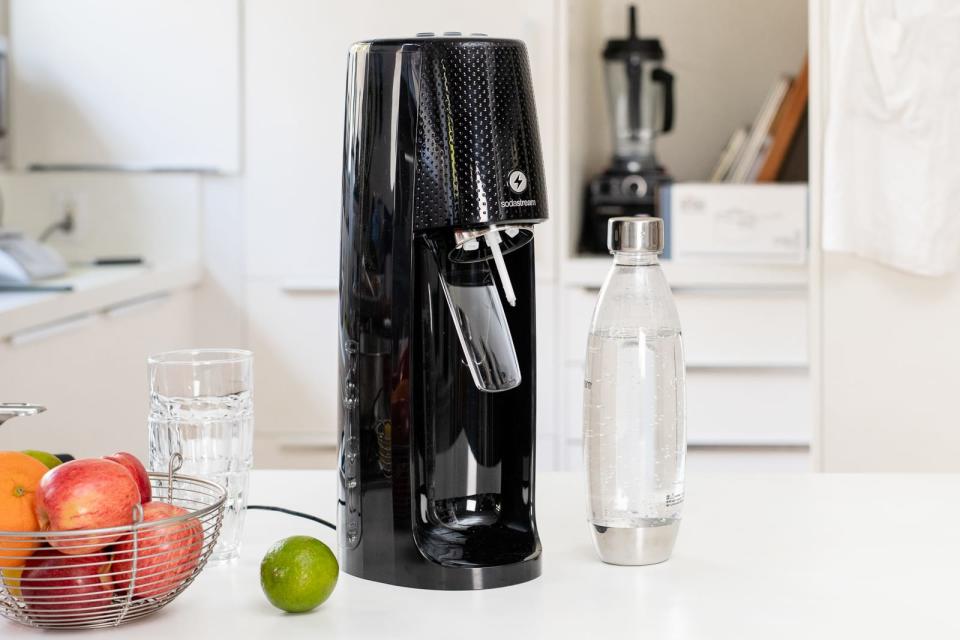
The SodaStream Fizzi OneTouch makes great-tasting sparkling water, and it's easy to customize your level of fizz. Like most SodaStream models, the water it makes is consistently delicious and perfectly fizzed. And thanks to the machine's sleek and straightforward design, the Fizzi OneTouch is also one of the simplest soda makers to use, clean, and refill.
In our tests, the Fizzi OneTouch produced very fizzy water with a rounded, zippy mouthfeel from a mix of large and small bubbles. "Like champagne bubbles" is how one tester described them.
The Fizzi OneTouch gives great control over fizz level: You simply press one of three buttons at the top of the machine to select a low, medium, or high amount of carbonation. Then the OneTouch carbonates automatically. If you'd like it fizzier than the fizziest button provides, you can just press one of the buttons again for a second round. While other machines left us unsure whether we had carbonated sufficiently (sometimes even resulting in over-carbonated spillover, in the case of the more basic SodaStream Fizzi), with the Fizzi OneTouch you can just press the button and walk away, knowing the machine is doing exactly what you've asked of it.
Like most SodaStream models, the Fizzi OneTouch is streamlined and easy to use. It works with SodaStream's 60-liter CO2 cylinders, which are easy to screw into the back of the machine and widely available to exchange. The water bottle also clips onto the machine easily: Simply insert the neck of the bottle into the machine at an angle and push back until it locks into place. In comparison, the iDrink Drinkmate requires some maneuvering to attach the fizz infuser cap to the bottle before locking both into the carbonator.
The Fizzi OneTouch has a minimal footprint and is short enough to fit under most cabinets, measuring about 16½ inches tall, 5 inches wide, and 7½ inches deep.
Flaws but not dealbreakers
Unfortunately, unlike our former top pick, the now-discontinued SodaStream Source, the OneTouch runs on electricity and requires an outlet, so you are somewhat limited in where you can put it. But we think that limitation is outweighed by the fact that automation makes the OneTouch so easy to use. Additionally, while the Source came with a limited lifetime warranty, the Fizzi OneTouch's (as well as all newer SodaStream models') warranty lasts only two years. That said, many small kitchen appliances only come with a one-year warranty, so two years is still decent coverage.
The Fizzi OneTouch's bottles, like all SodaStream models, are not dishwasher-safe, and they have scratched and yellowed a bit during our long-term testing. And all SodaStream bottles come with expiration dates printed on them. You need to replace them every few years to avoid the (small) risk of the older, weakened plastic exploding. A new double-pack of bottles costs about $20.
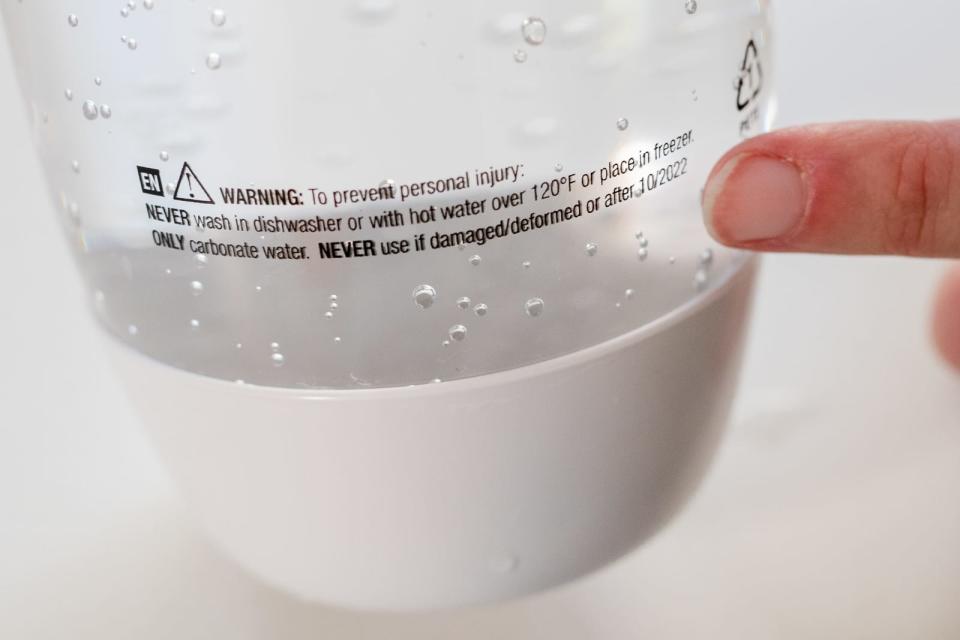
Note too that SodaStream will void your warranty if you carbonate anything other than water in its machines. Fizzing beverages such as juice or wine may also cause leaking or overflowing. Instead, to add flavor after carbonating water, you can buy sparkling-drink mix.
Runner-up: SodaStream Fizzi

If you're okay with compromising ease-of-use for a lower price or want a soda maker you can use without electricity, the SodaStream Fizzi makes a great pick. In our tests, water from the Fizzi was nearly indistinguishable in fizziness and taste from water we carbonated with the Fizzi OneTouch. But the Fizzi isn't automated; while the OneTouch allows you to simply press the button and walk away, the Fizzi requires deliberate attention, and it can be hard to tell when you've fizzed enough.
To carbonate water with the Fizzi, you press down on the top button in two-second increments one to three times, depending on how bubbly you want your water. This seems straightforward enough, but our first time using the machine, our estimate of two seconds was too generous (apparently SodaStream does not adhere to the Mississippi-counting school), which resulted in some water gushing from the top of the bottle while we pressed the button. But our second time using it, we had no issues.
The Fizzi improves on SodaStream's older basic models, like the Jet, with a simpler method of affixing the bottles. Whereas the Jet required you to screw in the bottle, the Fizzi lets you just pop it in with one simple movement, using the same mechanism as the OneTouch. The Fizzi also uses the same, easily exchangeable 60-liter carbonating cylinders as the Source and takes up a similarly small amount of counter space.
Using the Fizzi, though, we were surprised by the sound it made, which was slightly louder and more abrasive than the light gushing sound made by the OneTouch. SodaStream says the Fizzi should "make a puffing sound after the third press," but in our experience this puff wasn't dependably pronounced, making it hard to tell whether you'd fully fizzed or not.
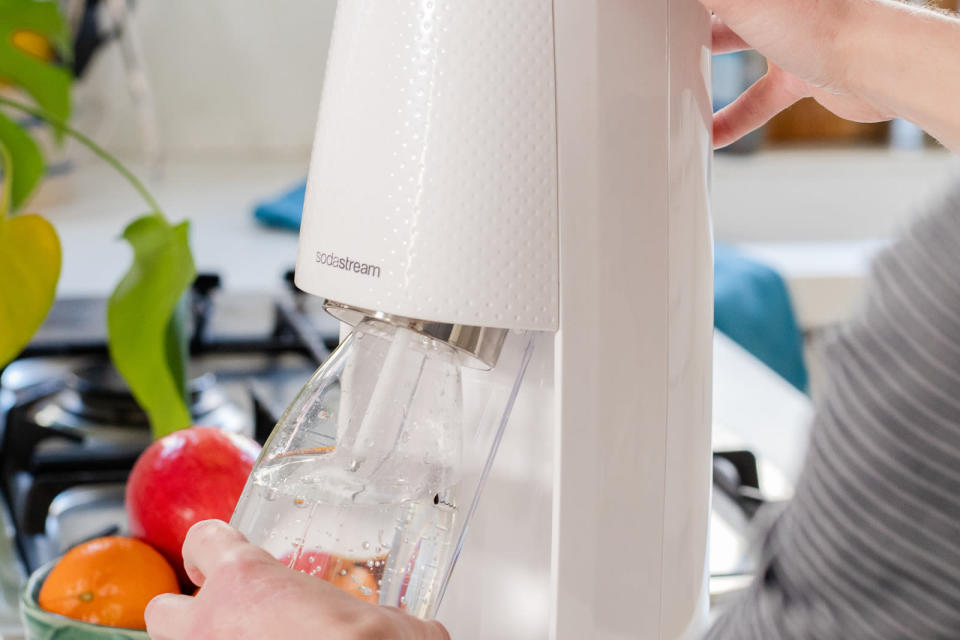
The Fizzi has a simple, streamlined look, sporting a no-frills plastic body available in several colors: black, white, red, pink, blue, or pale lime green (though we've seen stock issues with colors other than black and white). Like all SodaStream bottles, the Fizzis are also not safe for dishwashers. It makes a fine alternative if the OneTouch goes out of stock or suddenly becomes much more expensive.
Also great: iDrink Drinkmate

If you want to carbonate beverages such as juice, wine, or cocktails, we recommend the iDrink Drinkmate. Although the Drinkmate produced slightly fizzy water that wasn't as bubbly as that made by SodaStream models, it did live up to its unique claim to carbonate beverages other than water. In contrast, SodaStream will void your warranty and money-back guarantee if you carbonate beverages other than water, and your beverage will likely explode everywhere. (SodaStream does offer flavoring that you can add after carbonating.) In our tests, the Drinkmate carbonated apple juice, wine, and a mocktail with no problem. We also like that the machine comes with two bottle sizes, which can be handy if you're making components of a cocktail, for example. Plus, the Drinkmate is compatible with SodaStream's carbonator cylinders, so you can easily find refills.
The Drinkmate requires a few extra steps to carbonate and then release pressure. That's because drinks such as juice or wine have more solutes in them, which form smaller and more copious bubbles when combined with CO2. This reaction makes beverages extra fizzy, and in the case of home soda makers, it can cause the liquid to fizz out of the bottle. Most of the experts we spoke with described experiencing a SodaStream overflow or explosion at some point when trying to carbonate juices or other beverages. But the Drinkmate has a pressure release valve in the bottle cap that helps counter this effect.
Compared with all of the SodaStream machines we tried, however, the Drinkmate was more difficult to use. Instead of just popping the bottle in, you need first to secure the Drinkmate's fizz infuser cap to the bottle, then slide the bottle into the machine. The instructions say to press the button until you hear a hiss, which isn't an exact process. Then, you must remove the bottle, shake it gently, and release the pressure using a silver tab before removing the cap. Alternatively, you can press a quick-release valve to relieve the pressure, but the bottle did fizz over a bit when we tried this after carbonating apple juice.
In our tests, the Drinkmate produced merely adequate fizz in water—the SodaStream models we tested produced much more. The Drinkmate also doesn't offer any fine-tuning options for fizz control—you repeatedly press a button until you hear a hiss that signals you've carbonated your beverage.
But the Drinkmate stands out for its ability to directly carbonate drinks such as juice and wine. We carbonated apple juice in this soda maker and compared the results side by side with bottled sparkling apple juice from the same brand. The Drinkmate produced a lush, bubbly carbonated juice with large bubbles and a zippy mouthfeel that our testers unanimously loved. Testers said it was "way better" than the bottled juice.
We also tried carbonating rosé and a mocktail in the Drinkmate, and it successfully did both. Because this machine is the only countertop model we've found that can carbonate any kind of drink, we think it's a great option for people who are interested in carbonating juice, wine, or premade cocktails in addition to water.
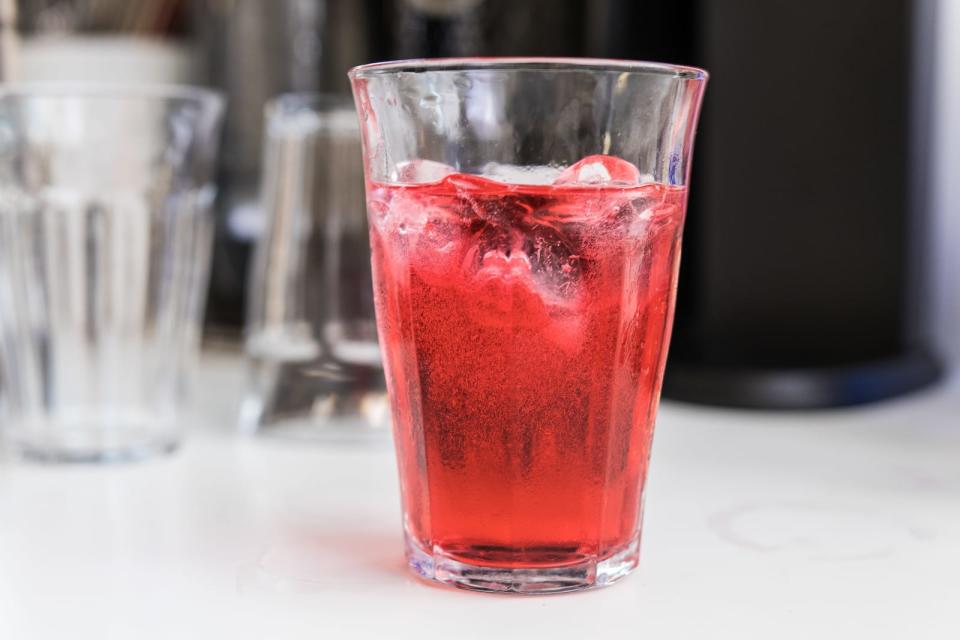
The competition
In our years of testing, we've tested or considered a number of SodaStream models. Many have since been discontinued, such as the Penguin, Crystal, Genesis, and Power. Here's what we've dismissed:
The SodaStream Source was our former top pick, but it's since been discontinued. We thought it produced bubbles as well as other SodaStream models, but we liked the additional LED light which indicates when you've reached your desired fizz level, and we appreciated the fact that its battery-powered design made it usable from anywhere in your home.
The Fountain is an older model that lacks features and requires you to screw the bottle into the machine rather than simply pop it into place.
We previously tested the Jet, an older basic model, but it didn't impress us. After we injected six button presses of carbon dioxide (the suggested amount is three for normal fizz), its water was still not as fizzy as the Source's we tested it against. It also requires you to screw in the water bottle and has a clunkier-looking design.
The Aarke Carbonator II looks very stylish, but we think it lacks enough features to justify the $200 price tag. You have to screw the bottle in, which takes more time and effort than it does to lock the bottle in place on the SodaStream Fizzi OneTouch or Fizzi. And like the much less expensive Fizzi, it provides no visual indication of how much you've fizzed the water.
Bonne O Sparkling Beverage System: The Bonne O, unlike any other soda maker we looked at, uses tabs of "citric acid, potassium bicarbonate, sodium bicarbonate (baking soda), potassium carbonate" to carbonate water instead of injecting carbon dioxide. The first four times we tried to use it, the water was not carbonated and had a salty, sulphuric taste. Although the tabs go into a separate chamber and are not supposed to enter the water bottle, we could immediately tell from the water's taste that they did. We also found the bottle difficult to attach and the machine cumbersome to clean.
iSi Soda Siphon: We tested the iSi for the first two versions of this guide. It ranked the lowest overall among our taste testers in taste, bubble size, and overall fizziness of the water. Cleaning is also hard: To remove an inner chamber to clean the bottle, you need a special tool (and that's something we're sure we would lose in about two weeks).
Hamilton Beach Fizzini: This model is an extremely inexpensive option, but it gets varied reviews and requires single-use cartridges such as a soda siphon. On Amazon, at the time of writing, a pack of 10 8-gram refill cartridges costs around $15, almost as much as the machine itself, so we decided not to test it.
This guide may have been updated by Wirecutter. To see the current recommendation, please go here.
When readers choose to buy Wirecutter's independently chosen editorial picks, Wirecutter and Engadget may earn affiliate commissions.
